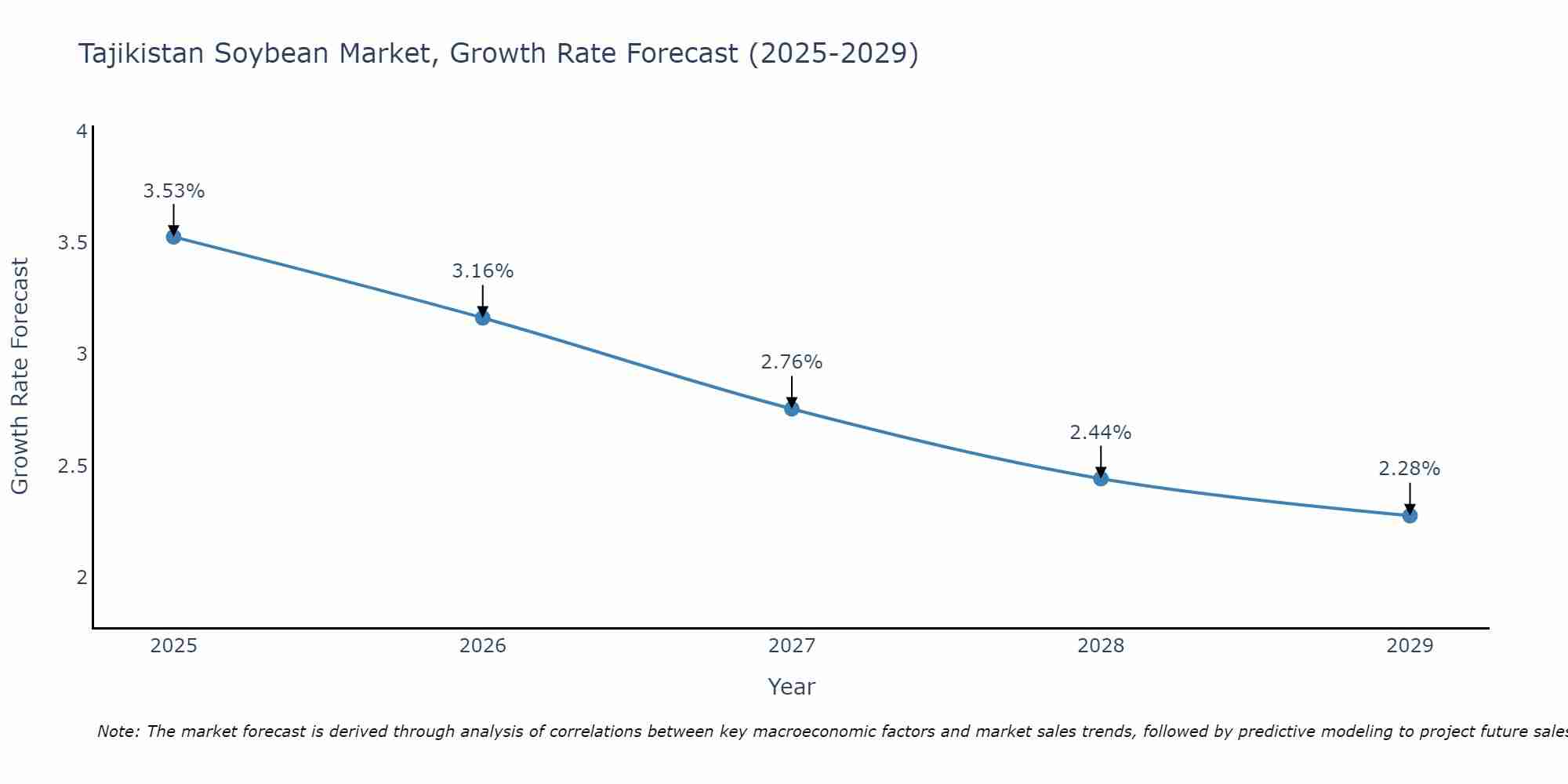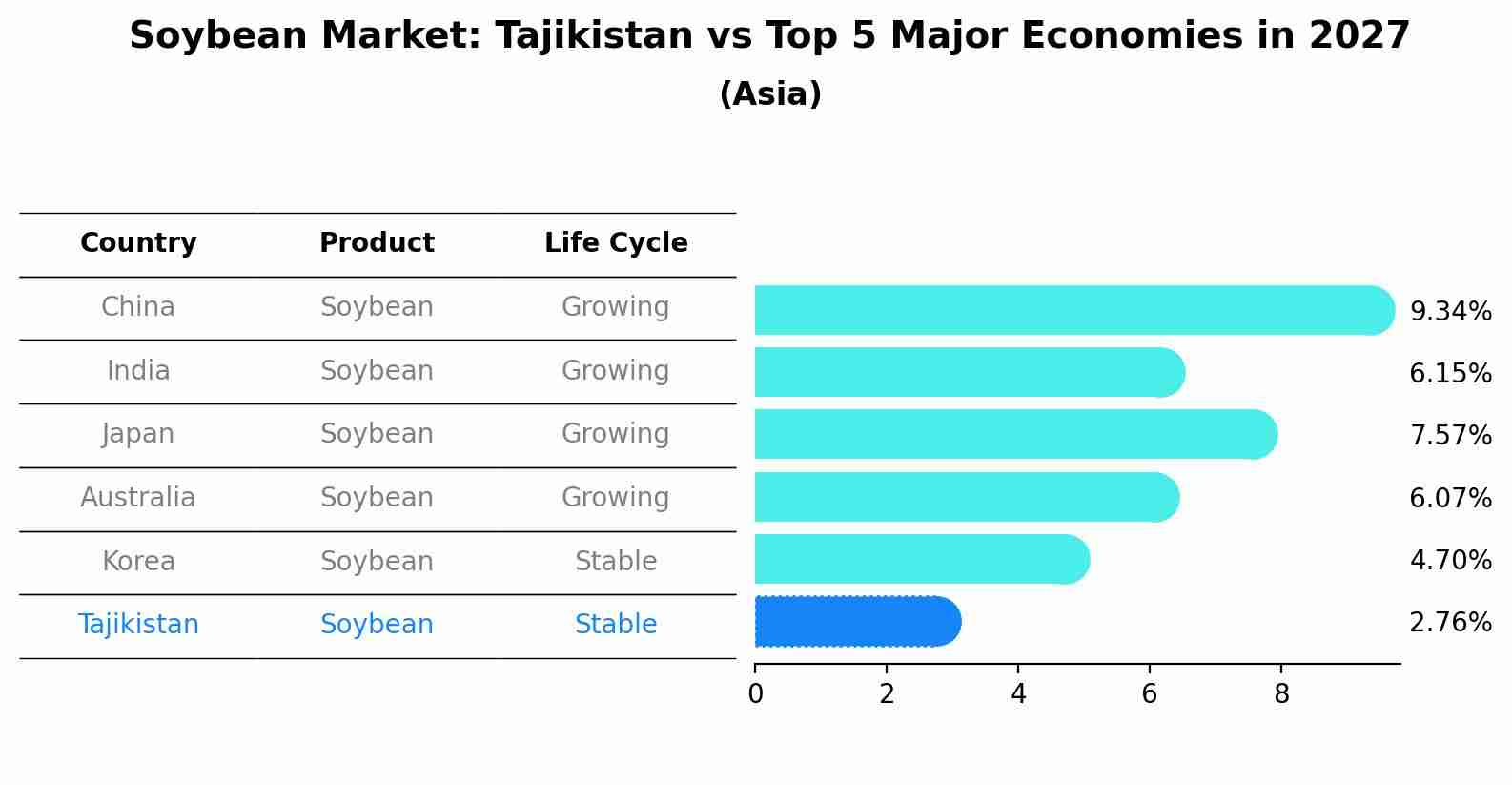Tajikistan Soybean Market (2025-2031) Outlook | Size, Companies, Trends, Share, Revenue, Value, Analysis, Industry, Growth & Forecast
| Product Code: ETC224699 | Publication Date: Aug 2022 | Updated Date: Aug 2025 | Product Type: Market Research Report | |
| Publisher: 6Wresearch | Author: Shubham Padhi | No. of Pages: 75 | No. of Figures: 35 | No. of Tables: 20 |
Tajikistan Soybean Market Size Growth Rate
The Tajikistan Soybean Market may undergo a gradual slowdown in growth rates between 2025 and 2029. Beginning strongly at 3.53% in 2025, growth softens to 2.28% in 2029.

Soybean Market: Tajikistan vs Top 5 Major Economies in 2027 (Asia)
By 2027, Tajikistan's Soybean market is forecasted to achieve a stable growth rate of 2.76%, with China leading the Asia region, followed by India, Japan, Australia and South Korea.

Tajikistan Soybean Market Overview
The soybean market in Tajikistan is relatively small but has been showing growth potential in recent years. Soybeans are primarily imported to meet the country`s demand for soy products, including soybean oil and soybean meal for animal feed. The government has been encouraging domestic production of soybeans to reduce reliance on imports and boost the agricultural sector. Challenges such as limited arable land, lack of modern farming techniques, and fluctuating global prices remain obstacles to the expansion of the soybean market in Tajikistan. However, with increasing awareness of the health benefits of soy products and support from the government, there is a growing interest among farmers to cultivate soybeans, indicating a positive outlook for the market`s future growth.
Tajikistan Soybean Market Trends
In Tajikistan, the soybean market is experiencing growth due to increasing demand for soy products in the food industry and livestock feed sector. Local farmers are increasingly cultivating soybeans to capitalize on the rising demand, leading to a boost in domestic production. The government`s initiatives to promote soybean cultivation and provide support to farmers are also contributing to the market growth. Additionally, the import of soybeans for processing purposes is on the rise, as more companies are investing in soybean processing facilities in the country. Overall, the Tajikistan soybean market is witnessing a positive trend with opportunities for further expansion and development in both domestic production and processing capabilities.
Tajikistan Soybean Market Challenges
In the Tajikistan Soybean Market, challenges include limited agricultural infrastructure, such as irrigation systems and storage facilities, which hinders efficient production and distribution. Additionally, fluctuating weather conditions and a lack of advanced technologies for crop management contribute to yield variability and quality issues. Import restrictions and tariffs on soybean products further impede market growth and limit access to international markets. Inadequate access to financing and technical assistance for farmers also restricts expansion and modernization efforts in the sector. Addressing these challenges will be crucial for the Tajikistan Soybean Market to realize its full potential and improve competitiveness both domestically and globally.
Tajikistan Soybean Market Investment Opportunities
The Tajikistan soybean market presents promising investment opportunities due to the country`s growing demand for soybeans driven by its expanding livestock and poultry industries. Investing in soybean production in Tajikistan can be lucrative as the country aims to reduce its reliance on imported soybeans. Additionally, the government is implementing policies to support agricultural development, providing incentives for investments in the sector. With fertile land and a favorable climate for soybean cultivation, there is potential for high yields and profitability. Partnering with local farmers or establishing soybean processing facilities could also be viable investment options in Tajikistan`s soybean market, tapping into the growing demand for soy-based products both locally and regionally.
Tajikistan Soybean Market Government Policy
The government of Tajikistan has implemented several policies to support and promote the soybean market in the country. This includes providing subsidies and incentives to farmers to increase soybean production, improving infrastructure for storage and transportation of soybeans, and offering training and technical support to enhance agricultural practices. Additionally, the government has focused on developing partnerships with international organizations and other countries to facilitate knowledge exchange and access to markets for Tajikistan`s soybean products. These policies aim to boost domestic production, reduce reliance on imports, and create opportunities for economic growth within the soybean market in Tajikistan.
Tajikistan Soybean Market Future Outlook
The future outlook for the Tajikistan soybean market appears promising due to increasing demand for soybean products driven by a growing population and rising awareness of the health benefits associated with soy consumption. The government`s efforts to promote agricultural development and improve farming techniques also bode well for the sector. However, challenges such as limited arable land, dependence on imports for soybean seeds, and vulnerability to global market fluctuations may hinder the market`s growth potential. To capitalize on the opportunities in the market, stakeholders need to focus on enhancing local production, investing in technology and infrastructure, and fostering partnerships with international suppliers and buyers to ensure a sustainable and competitive soybean market in Tajikistan.
Key Highlights of the Report:
- Tajikistan Soybean Market Outlook
- Market Size of Tajikistan Soybean Market, 2024
- Forecast of Tajikistan Soybean Market, 2031
- Historical Data and Forecast of Tajikistan Soybean Revenues & Volume for the Period 2021 - 2031
- Tajikistan Soybean Market Trend Evolution
- Tajikistan Soybean Market Drivers and Challenges
- Tajikistan Soybean Price Trends
- Tajikistan Soybean Porter's Five Forces
- Tajikistan Soybean Industry Life Cycle
- Historical Data and Forecast of Tajikistan Soybean Market Revenues & Volume By Applications for the Period 2021 - 2031
- Historical Data and Forecast of Tajikistan Soybean Market Revenues & Volume By Crush for the Period 2021 - 2031
- Historical Data and Forecast of Tajikistan Soybean Market Revenues & Volume By Feed Use for the Period 2021 - 2031
- Historical Data and Forecast of Tajikistan Soybean Market Revenues & Volume By Food Use for the Period 2021 - 2031
- Tajikistan Soybean Import Export Trade Statistics
- Market Opportunity Assessment By Applications
- Tajikistan Soybean Top Companies Market Share
- Tajikistan Soybean Competitive Benchmarking By Technical and Operational Parameters
- Tajikistan Soybean Company Profiles
- Tajikistan Soybean Key Strategic Recommendations
Frequently Asked Questions About the Market Study (FAQs):
1 Executive Summary |
2 Introduction |
2.1 Key Highlights of the Report |
2.2 Report Description |
2.3 Market Scope & Segmentation |
2.4 Research Methodology |
2.5 Assumptions |
3 Tajikistan Soybean Market Overview |
3.1 Tajikistan Country Macro Economic Indicators |
3.2 Tajikistan Soybean Market Revenues & Volume, 2021 & 2031F |
3.3 Tajikistan Soybean Market - Industry Life Cycle |
3.4 Tajikistan Soybean Market - Porter's Five Forces |
3.5 Tajikistan Soybean Market Revenues & Volume Share, By Applications, 2021 & 2031F |
4 Tajikistan Soybean Market Dynamics |
4.1 Impact Analysis |
4.2 Market Drivers |
4.2.1 Increasing demand for soybean products in Tajikistan due to changing dietary habits and growing health awareness. |
4.2.2 Government initiatives to promote soybean cultivation and processing in the country. |
4.2.3 Favorable weather conditions and suitable agricultural land for soybean cultivation in Tajikistan. |
4.3 Market Restraints |
4.3.1 Lack of modern agricultural technologies and infrastructure hindering efficient soybean production. |
4.3.2 Limited availability of skilled labor in the agricultural sector. |
4.3.3 Fluctuating prices of soybeans in the global market impacting local production and consumption. |
5 Tajikistan Soybean Market Trends |
6 Tajikistan Soybean Market, By Types |
6.1 Tajikistan Soybean Market, By Applications |
6.1.1 Overview and Analysis |
6.1.2 Tajikistan Soybean Market Revenues & Volume, By Applications, 2021 - 2031F |
6.1.3 Tajikistan Soybean Market Revenues & Volume, By Crush, 2021 - 2031F |
6.1.4 Tajikistan Soybean Market Revenues & Volume, By Feed Use, 2021 - 2031F |
6.1.5 Tajikistan Soybean Market Revenues & Volume, By Food Use, 2021 - 2031F |
7 Tajikistan Soybean Market Import-Export Trade Statistics |
7.1 Tajikistan Soybean Market Export to Major Countries |
7.2 Tajikistan Soybean Market Imports from Major Countries |
8 Tajikistan Soybean Market Key Performance Indicators |
8.1 Average yield per hectare of soybean crops in Tajikistan. |
8.2 Percentage increase in the area of land dedicated to soybean cultivation. |
8.3 Adoption rate of modern agricultural practices among soybean farmers in Tajikistan. |
9 Tajikistan Soybean Market - Opportunity Assessment |
9.1 Tajikistan Soybean Market Opportunity Assessment, By Applications, 2021 & 2031F |
10 Tajikistan Soybean Market - Competitive Landscape |
10.1 Tajikistan Soybean Market Revenue Share, By Companies, 2024 |
10.2 Tajikistan Soybean Market Competitive Benchmarking, By Operating and Technical Parameters |
11 Company Profiles |
12 Recommendations |
13 Disclaimer |
- Single User License$ 1,995
- Department License$ 2,400
- Site License$ 3,120
- Global License$ 3,795
Search
Thought Leadership and Analyst Meet
Our Clients
Related Reports
- Afghanistan Apparel Market (2026-2032) | Growth, Outlook, Industry, Segmentation, Forecast, Size, Companies, Trends, Value, Share, Analysis & Revenue
- Canada Oil and Gas Market (2026-2032) | Share, Segmentation, Value, Industry, Trends, Forecast, Analysis, Size & Revenue, Growth, Competitive Landscape, Outlook, Companies
- Germany Breakfast Food Market (2026-2032) | Industry, Share, Growth, Size, Companies, Value, Analysis, Revenue, Trends, Forecast & Outlook
- Australia Briquette Market (2025-2031) | Growth, Size, Revenue, Forecast, Analysis, Trends, Value, Share, Industry & Companies
- Vietnam System Integrator Market (2025-2031) | Size, Companies, Analysis, Industry, Value, Forecast, Growth, Trends, Revenue & Share
- ASEAN and Thailand Brain Health Supplements Market (2025-2031) | Strategy, Consumer Insights, Analysis, Investment Trends, Opportunities, Growth, Size, Share, Industry, Revenue, Segments, Value, Segmentation, Supply, Forecast, Restraints, Outlook, Competition, Drivers, Trends, Demand, Pricing Analysis, Competitive, Strategic Insights, Companies, Challenges
- ASEAN Bearings Market (2025-2031) | Strategy, Consumer Insights, Analysis, Investment Trends, Opportunities, Growth, Size, Share, Industry, Revenue, Segments, Value, Segmentation, Supply, Forecast, Restraints, Outlook, Competition, Drivers, Trends, Demand, Pricing Analysis, Competitive, Strategic Insights, Companies, Challenges
- Europe Flooring Market (2025-2031) | Outlook, Share, Industry, Trends, Forecast, Companies, Revenue, Size, Analysis, Growth & Value
- Saudi Arabia Manlift Market (2025-2031) | Outlook, Size, Growth, Trends, Companies, Industry, Revenue, Value, Share, Forecast & Analysis
- Uganda Excavator, Crane, and Wheel Loaders Market (2025-2031) | Strategy, Consumer Insights, Analysis, Investment Trends, Opportunities, Growth, Size, Share, Industry, Revenue, Segments, Value, Segmentation, Supply, Forecast, Restraints, Outlook, Competition, Drivers, Trends, Demand, Pricing Analysis, Competitive, Strategic Insights, Companies, Challenges
Industry Events and Analyst Meet
Whitepaper
- Middle East & Africa Commercial Security Market Click here to view more.
- Middle East & Africa Fire Safety Systems & Equipment Market Click here to view more.
- GCC Drone Market Click here to view more.
- Middle East Lighting Fixture Market Click here to view more.
- GCC Physical & Perimeter Security Market Click here to view more.
6WResearch In News
- Doha a strategic location for EV manufacturing hub: IPA Qatar
- Demand for luxury TVs surging in the GCC, says Samsung
- Empowering Growth: The Thriving Journey of Bangladesh’s Cable Industry
- Demand for luxury TVs surging in the GCC, says Samsung
- Video call with a traditional healer? Once unthinkable, it’s now common in South Africa
- Intelligent Buildings To Smooth GCC’s Path To Net Zero


















